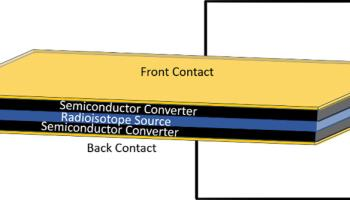New Approach to Radioisotope Power Sources for Improved Efficiency, Long Life

Image courtesy of Oak Ridge National Laboratory and Army Research Laboratory. Direct deposition of a radioisotope source onto a converter. This can improve conversion of the radioisotope source’s beta decay emissions to electricity by using two converters instead of one. The result is greater power density for the power source.
The Science
Beta-voltaic radioisotope power sources (RPSs) are devices that directly convert beta particles (electrons) from a beta-emitting radioisotope source (such as nickel-63) into electrical energy. These devices have high power density, meaning they can release a large amount of power quickly when needed. They also have a high energy density, meaning they store large amounts of power. They are ideal for applications like spacecraft that need power sources that can operate for many years under harsh conditions without human intervention. Researchers recently explored a new approach for making beta-voltaic RPSs more efficient at converting heat into electricity. These NextGen RPSs apply isotopes in new ways to improve converters. This gives NextGen RPSs excellent potential for providing long-term, compact power in remote and extreme environments.




